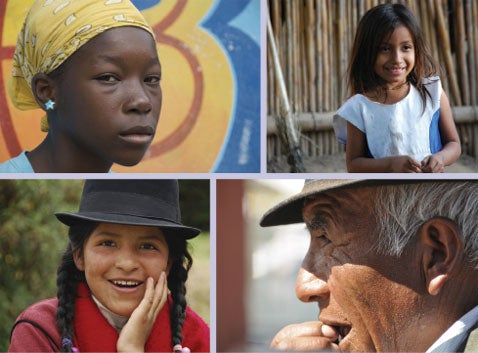

Deaths from cancer are decreasing in some countries of the Americas and for certain kinds of cancer, while deaths from other cancer types are on the rise in the region, according to a new report from the Pan American Health Organization (PAHO), Regional Office for the Americas of the World Health Organization (WHO).
Nine countries show overall cancer deaths decreasing over the past decade, although certain types of cancer deaths are on the rise
Washington, D.C., 5 November 2013 (PAHO/WHO) — Deaths from cancer are decreasing in some countries of the Americas and for certain kinds of cancer, while deaths from other cancer types are on the rise in the region, according to a new report from the Pan American Health Organization (PAHO), Regional Office for the Americas of the World Health Organization (WHO).
Overall, cancer is holding steady as the second-leading cause of death in the Americas, claiming an estimated 1.2 million lives each year, according to Cancer in the Americas: Country Profiles, 2013, released this week at the 5th International Cancer Control Congress (Nov. 3—6) in Lima, Peru.
The PAHO/WHO report shows that Latin America and the Caribbean account for approximately 50% of cancer deaths in the Americas, although they account for 63% of the hemisphere's population. The highest cancer mortality rates in the region are found in Trinidad and Tobago, Cuba and Argentina, based on data provided to PAHO/WHO by its member countries. Mexico, Nicaragua and El Salvador have the lowest cancer mortality rates. Cancer deaths overall are declining in nine countries: Argentina, Brazil, Canada, Chile, Mexico, Nicaragua, Paraguay, Venezuela and the United States.
Cancer mortality rates vary for men and women as well as across countries. In Latin American and Caribbean men, the majority of cancer deaths are due to prostate cancer, followed by lung, stomach and colorectal cancers; and in women, breast cancer, followed by stomach, lung, cervical and colorectal cancers. In contrast, in Canada and the United States lung cancer is the leading cancer killer for both sexes.
Cancer morality is typically higher in men, driven by high rates of lung and prostate cancers. The exceptions are in El Salvador and Nicaragua, where female rates are higher owing to deaths from cervical and stomach cancers.
"The large number of deaths from breast and cervical cancer in Latin America and the Caribbean is very disconcerting, since cervical cancer is largely preventable, and breast cancer can be detected early and treated successfully,'' said Silvana Luciani, PAHO/WHO advisor on cancer prevention and control. ''This points to the need to improve screening and treatment, especially for women in rural and remote areas, where access to health services is especially limited."
Other highlights of the report include (see link below for more highlights):
- In most (22) countries of the Americas, breast cancer is the leading cancer cause of death for women, while in three countries—Honduras, Nicaragua and Bolivia—cervical cancer continues to be the leading cause of cancer death in women.
- In most (18) of the region's countries, prostate cancer is the leading cancer cause of death for men.
- Stomach cancer is a significant problem in Central America and the Andean region. It is the leading cancer cause of death for both men and women in El Salvador, Guatemala, Honduras, Ecuador and Peru, and for men only in Bolivia, Chile and Colombia.
- Gallbladder cancer, a relatively uncommon cancer type in most countries, is the second-leading cause of cancer deaths for women in Chile.
- Lung cancer mortality is decreasing for both men and women in Canada, Mexico, Nicaragua and the United States (rates are fairly stable in other countries).
- Breast cancer mortality rates are decreasing in Canada, the United States and Argentina while increasing in Costa Rica and Ecuador.
- Cervical cancer mortality has declined significantly in 11 countries of the region—Brazil, Canada, Chile, Colombia, Costa Rica, El Salvador, Mexico, Nicaragua, Panama, Venezuela and the United States.
- Prostate cancer deaths are declining in seven countries—Argentina, Canada, Mexico, Nicaragua, Panama, Venezuela and the United States—while increasing in Cuba.
- Adult tobacco smoking—the most significant risk factor for cancer—is highest in Chile, Bolivia and Uruguay.
- Obesity, another important cancer risk factor, is highest in English-speaking Caribbean countries, notably Bahamas, Belize, Saint Kitts and Nevis, and Trinidad and Tobago.
The report is based on recent data compiled by PAHO/WHO about cancer mortality, risk factors, and cancer policies and services in the countries of North, South and Central America and the Caribbean. For each country, data are presented for leading cancer types (ranked by mortality); trends in cancer deaths from 2000 to 2010; main cancer risk factors (tobacco, alcohol, diet, physical inactivity, obesity); key socio-demographic factors; and health sector plans, policies and services for cancer.
"The idea is to provide key information that can help countries monitor progress in cancer control and assess areas of need, "said Luciani. "This report contributes significantly to the evidence base for cancer policymaking and health care."
The report is part of PAHO/WHO's efforts to support member countries as they address the growing epidemic of noncommunicable diseases (NCDs). PAHO/WHO is also working with countries and partner organizations to develop and implement comprehensive cancer control programs within the framework of the PAHO/WHO Strategy and Plan of Action on NCDs, whose specific activities include:
- Expanding immunization against infections that cause certain types of cancer, such as cervical cancer (HPV) and liver cancer (hepatitis B).
- Strengthening public health policies for cancer prevention, including policies on tobacco control, alcohol reduction, diet and physical activity.
- Enhancing regulations on and protection against carcinogens in the workplace and in the environment.
- Improving quality of and access to screening programs, especially for early detection of cervical and breast cancers.
- Improving the quality of radiotherapy services.
- Expanding access to cancer drugs and palliative care.
- Strengthening cancer information systems and registries.
PAHO, founded in 1902, is the oldest international public health organization in the world. It works with its member countries to improve the health and the quality of life of the people of the Americas. It serves as the Regional Office for the Americas of WHO and is part of the Inter-American system.
Links:
- Cancer in the Americas: Country Profiles 2013
- 5th International Cancer Control Congress (ICCC5)
- www.ICCC5.com
- PAHO cancer
- https://twitter.com/pahowho #cancer
Media Contacts:
Leticia Linn, linnl@paho.org, Tel. + 202 974 3440, Mobile +1 202 701 4005, Donna Eberwine-Villagran, eberwind@paho.org, Tel. +1 202 974 3122, Mobile +1 202 316 5469, Sebastián Oliel, oliels@paho.org, Mobile +1 202 316 5679, Knowledge Management and Communications, PAHO/WHO—www.paho.org
Highlights from Cancer in the Americas: Country Profiles 2013*
Cancer mortality
- The highest cancer mortality rates in the Americas are found in Trinidad and Tobago, Cuba and Argentina.
- Mexico, Nicaragua and El Salvador have the lowest cancer mortality rates in the region.
Cancer types
- In most (22) countries of the Americas, breast cancer is the leading cancer cause of death for women.
- In most (18) of the region's countries, prostate cancer is the leading cancer cause of death for men.
- Stomach cancer is the leading cancer cause of death for both men and women in El Salvador, Guatemala, Honduras, Ecuador and Peru and for men only in Bolivia, Chile and Colombia.
- Cervical cancer is the leading cancer killer of women in Honduras, Nicaragua and Bolivia.
- Gallbladder cancer, a relatively uncommon cancer type, is the second-leading cause of cancer deaths in women in Chile.
Risk factors
- Adult tobacco smoking—the single most important risk factor for cancer—is highest in Chile, Bolivia and Uruguay.
- Chile, Jamaica, Ecuador and Barbados have the highest prevalence of adolescent tobacco smoking, suggesting that future lung cancer rates in these countries could be high.
- Obesity (BMI?30), another key risk factor for cancer, is highest in English-speaking Caribbean countries, notably Bahamas, Belize, Saint Kitts and Nevis and Trinidad and Tobago.
Trends 2000-2010
- Overall cancer mortality is decreasing in nine countries—Argentina, Brazil, Canada, Chile, Mexico, Nicaragua, Paraguay, Venezuela, and the United States—while increasing slightly in Cuba. Rates are fairly stable in most other countries.
- Female lung cancer mortality is increasing in South America, especially in Argentina, Chile, Colombia and Peru.
- Lung cancer mortality is decreasing for both men and women in Canada, Mexico, Nicaragua and the United States.
- Breast cancer mortality rates are decreasing in Canada, the United States and Argentina while increasing in Costa Rica and Ecuador.
- Cervical cancer mortality has declined significantly in 11 countries in the region—Brazil, Canada, Chile, Colombia, Costa Rica, El Salvador, Mexico, Nicaragua, Panama, Venezuela and the United States.
- Prostate cancer deaths are declining in seven countries—Argentina, Canada, Mexico, Nicaragua, Panama, Venezuela and the United States—while increasing in Cuba.
- Colorectal cancer deaths are on the rise in five countries—Chile (in men), Ecuador, Mexico, Paraguay (in men) and Peru—and in Puerto Rico.
Public health capacity
- Only 10 of the region's 35 countries meet the international standard for minimum radiotherapy services coverage, that is, at least two radiation units per 1 million inhabitants.
- Nearly all the region's countries—except Canada and the United States—have very limited access to opioids (<13 mg total morphine equivalents per capita).
- Only 13 of 35 countries reported having introduced vaccines for HPV—which causes cervical cancer—into their national immunization programs: Argentina, Colombia, Canada, Guyana, Mexico, Panama, Paraguay, Peru, Puerto Rico, Suriname, Trinidad and Tobago, Uruguay and the United States.



